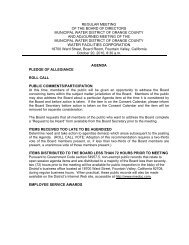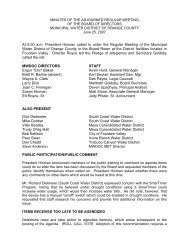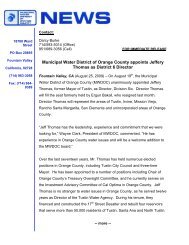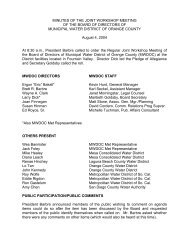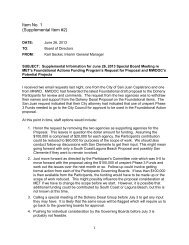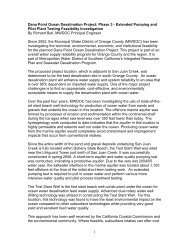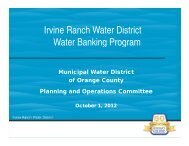UWM Plan - Municipal Water District of Orange County
UWM Plan - Municipal Water District of Orange County
UWM Plan - Municipal Water District of Orange County
You also want an ePaper? Increase the reach of your titles
YUMPU automatically turns print PDFs into web optimized ePapers that Google loves.
Section 7<br />
Future <strong>Water</strong> Supply Projects and Programs<br />
To accommodate long-term population and economic growth in Southern California, and<br />
to protect against uncertainty and more extreme variability in natural water supply, as<br />
well as development and depletion <strong>of</strong> water resources outside <strong>of</strong> Southern California,<br />
continuing regional and local efforts in water resource management and supply<br />
development will be necessary. Application <strong>of</strong> desalination technology is increasingly<br />
being recognized as one important supply component to develop new sustainable water<br />
supplies and to bolster water system reliability. Overall supply shortage risks from<br />
drought, regulatory constraints on existing supplies and emergency outages can be<br />
lessened with a diversified and disaggregated water supply portfolio that incorporates<br />
appropriate desalination projects. The different opportunities for desalinated water in<br />
MWDOC’s service area are shown in Table 7-2.<br />
In <strong>Orange</strong> <strong>County</strong>, there are three proposed ocean desalination projects that could serve<br />
MWDOC and its member agencies with additional water supply. These are the<br />
Huntington Beach Seawater Desalination Project, the South <strong>Orange</strong> Coastal Ocean<br />
Desalination Project, and the Camp Pendleton Seawater Desalination Project.<br />
Table 7-2: Opportunities for Desalinated <strong>Water</strong><br />
Sources <strong>of</strong> <strong>Water</strong><br />
Check if Yes<br />
Ocean <strong>Water</strong><br />
Brackish Ocean <strong>Water</strong><br />
Brackish Groundwater<br />
X<br />
X<br />
X<br />
7.4.1. Groundwater Desalination<br />
Metropolitan instituted its Groundwater Recovery Program in 1991 to provide financial<br />
incentives (up to $250 per acre-foot) to local agencies to develop brackish groundwater<br />
impaired from either natural causes or from agricultural drainage. The purpose <strong>of</strong> the<br />
program was to increase utilization <strong>of</strong> groundwater storage within the region for firm<br />
local production, conjunctive use storage, and drought supply. In MWDOC’s service<br />
area, five groundwater recovery brackish water projects have contracts with<br />
Metropolitan.<br />
Mesa Colored <strong>Water</strong> Treatment Facility Expansion - The Colored <strong>Water</strong> Treatment<br />
Facility (CWTF) is owned and operated by Mesa Consolidated <strong>Water</strong> <strong>District</strong> (Mesa).<br />
The CWTF pumps colored water from a deep colored water aquifer and removes the<br />
color using ozone treatment and biological filtration. Due to the increase in color and<br />
bromide in the source water, Mesa has embarked on a project to replace the ozone and<br />
biological filtration treatment with nan<strong>of</strong>iltration membrane treatment and increase the<br />
capacity from 5.8 MGD to 8.6 MGD. Design and construction <strong>of</strong> the technology<br />
<strong>Municipal</strong> <strong>Water</strong> <strong>District</strong> <strong>of</strong> <strong>Orange</strong> <strong>County</strong><br />
2010 Regional Urban <strong>Water</strong> Management <strong>Plan</strong><br />
Final<br />
7-5



